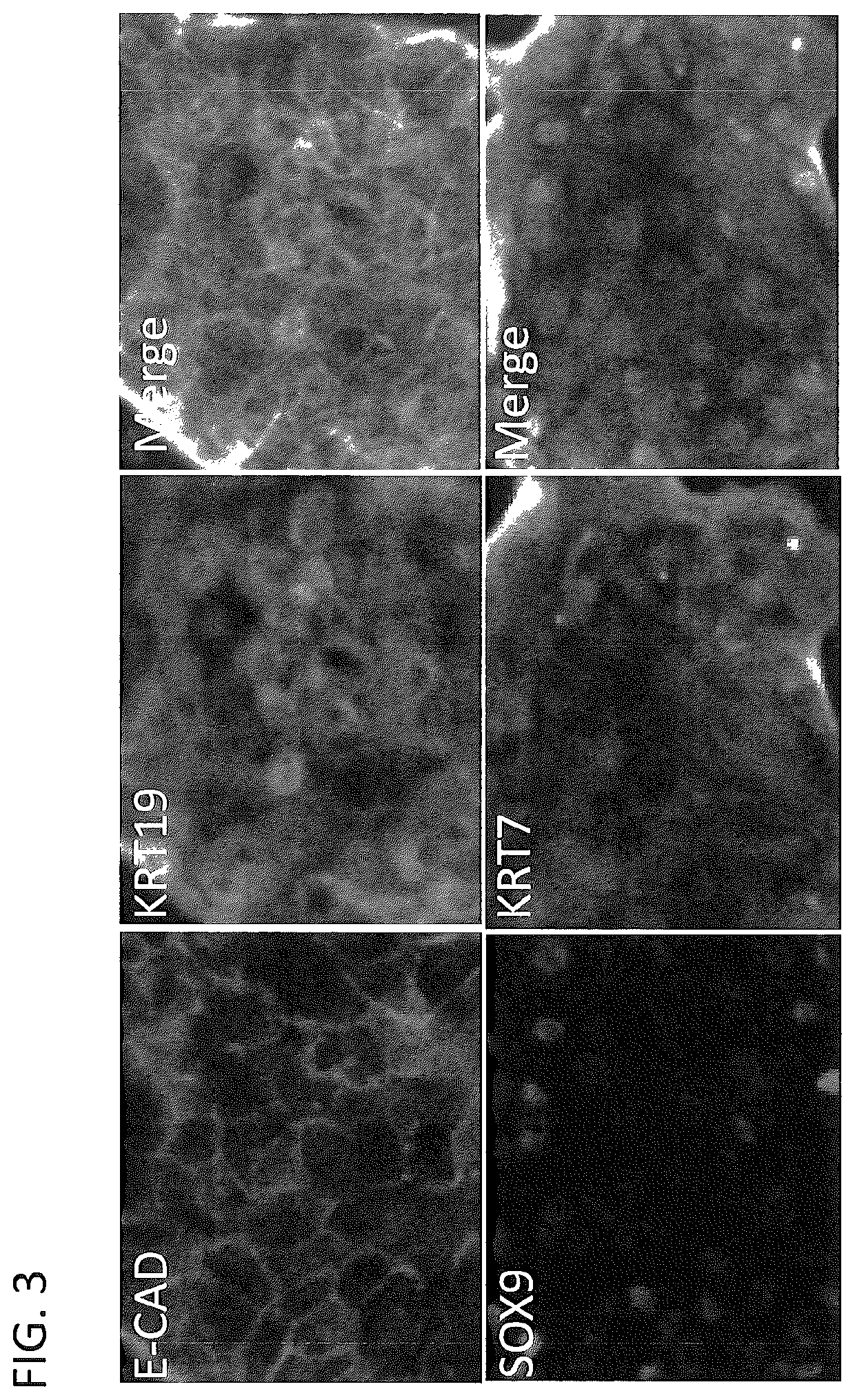Derivation of hepatic stem cells and mature liver cell types and uses thereof
a technology of liver cells and stem cells, applied in the field of stem cells and liver cell types derivation, can solve the problems of loss of cyp, no long-term culture method of primary hepatocytes, more patients dying while on the waiting list, etc., and achieve the effect of increasing cell metabolism
- Summary
- Abstract
- Description
- Claims
- Application Information
AI Technical Summary
Benefits of technology
Problems solved by technology
Method used
Image
Examples
example 1
Isolation and Long Term Culture of Human Liver Stem Cells
Materials & Methods:
[0307]Collagenase digestion Solution: DEME / F12 (Gibco) with 10 mM Hepes, 5% FBS (Clonetech), 2 mg / ml collagenase (Sigma, C-5138). Warm collagenase solution to 37 degree C., filter sterilize after the collagenase has gone into solution through a 0.2 micron filter. Make this media fresh (collagenase will inactivate at high temperatures and over long periods of time).
[0308]Washing solution: DEME / F12 medium with 10 mM HEPES (Gibco), 100U / ml Pen / Strep (Gibco), 100 μg / ml gentamicin (Gibco), filter sterilize solution through a 0.2 micron filter.
[0309]Coating medium: Growth factor reduced matrigel (Corning) 10%, diluted advanced F12 / DMEM reduced serum medium (Gibco).
[0310]Liver stem cell culture medium: Advanced F12 / DMEM reduced serum medium (1:1)(Gibco. 12643), 10 mM HEPES (Gibco), 100 U / ml Pen / Strep (Gibco), 2 mM L-Glutamine (Gibco), 1% N2 (Gibco), 2% B27 (Gibco), 50 ng / ml EGF (Millipore), 250 ng / ml R-Spondin1 (R...
example 2
Isolation and Long Term Culture of Mouse Liver Stem Cells
[0318]Liver stem cells described herein could be generated from both hepatocyte and non-hepatocyte liver populations in the liver. Mouse liver was digested into single cell suspension and labeled with bile duct marker EPCAM and the epithelial marker E-CAD. Cells of bile duct origin were EPCAM-positive and E-CAD-negative. Cells of hepatocyte origin were EPCAM-negative and E-cad-positive. Both bile duct and hepatocytes were isolated using FACS sorting and separately cultured using the methods described in the Examples. Liver stem cells were generated from both two cell populations (FIG. 7).
[0319]Liver stem cell culture medium was composed of Advanced F12 / DMEM reduced serum medium (1:1)(Gibco. 12643), 10 mM HEPES (Gibco), 100U / ml Pen / Strep (Gibco), 2 mM L-Glutamine (Gibco), 1% N2 (Gibco), 2% B27 (Gibco), 50 ng / ml EGF (Millipore), 250 ng / ml R-Spondin1 (R&D), 2 μM SB431542 (Tocris)), 2 μM T3 (3,3′,5-Triiodo-L-Thyronine) (Sigma), 10...
example 3
Differentiation of Liver Stem Cells to Hepatocytes
[0325]Liver Stem cells were able to differentiate into both hepatocyte and bile duct cell at near 100% efficiency. Hepatocyte differentiation were conducted in both 2D (FIG. 17), 3D (FIG. 24) and air liquid interface (ALI) format (FIG. 26). Bile duct differentiation was in 3D format (FIGS. 16A and 16B).
[0326]Hepatocyte differentiation medium consisted of Clonetics™ HCM™ Hepatocyte Culture Medium (Lonza) supplemented with 0.5 μM A83-01 (Tocris), 30 μM dexamethasone (Dex) (Sigma), 20 ng / ml oncostatin M (OSM) (Prospecbio), 0.1 μM γ-secretase inhibitor XXI, also called compound E (Santa cruz), 25 ng / ml Bmp7 and 25 ng / ml Fgf19.
[0327]In certain embodiments, Clonetics™ HCM™ Hepatocyte Culture Medium (Lonza) could be replaced with advanced DMEM / F12 (1:1) medium with B27, N2 or DMEM / F12 (1:1) medium with 10% FBS.
[0328]In certain embodiments, γ-secretase inhibitor XXI could be replaced with the Notch pathway inhibitor DAPT, DBZ.
[0329]In certai...
PUM
| Property | Measurement | Unit |
|---|---|---|
| concentration | aaaaa | aaaaa |
| concentration | aaaaa | aaaaa |
| concentration | aaaaa | aaaaa |
Abstract
Description
Claims
Application Information
 Login to View More
Login to View More - R&D
- Intellectual Property
- Life Sciences
- Materials
- Tech Scout
- Unparalleled Data Quality
- Higher Quality Content
- 60% Fewer Hallucinations
Browse by: Latest US Patents, China's latest patents, Technical Efficacy Thesaurus, Application Domain, Technology Topic, Popular Technical Reports.
© 2025 PatSnap. All rights reserved.Legal|Privacy policy|Modern Slavery Act Transparency Statement|Sitemap|About US| Contact US: help@patsnap.com



